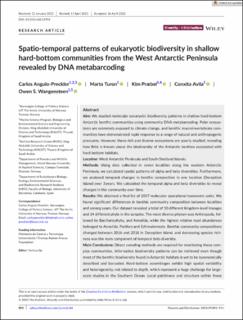| dc.contributor.author | Preckler, Carlos Angulo | |
| dc.contributor.author | Turon, Marta | |
| dc.contributor.author | Præbel, Kim | |
| dc.contributor.author | Avila, Conxita | |
| dc.contributor.author | Wangensteen, Owen S. | |
| dc.coverage.spatial | West Antarctic Penisula, South Shetland Islands | en_US |
| dc.date.accessioned | 2023-08-21T11:08:39Z | |
| dc.date.available | 2023-08-21T11:08:39Z | |
| dc.date.created | 2023-05-30T13:27:52Z | |
| dc.date.issued | 2023 | |
| dc.identifier.citation | Diversity and Distributions: A journal of biological invasions and biodiversity. 2023, . | en_US |
| dc.identifier.issn | 1366-9516 | |
| dc.identifier.uri | https://hdl.handle.net/11250/3085032 | |
| dc.description.abstract | We studied molecular eukaryotic biodiversity patterns in shallow hard-bottom Antarctic benthic communities using community DNA metabarcoding. Polar ecosystems are extremely exposed to climate change, and benthic macroinvertebrate communities have demonstrated rapid response to a range of natural and anthropogenic pressures. However, these rich and diverse ecosystems are poorly studied, revealing how little is known about the biodiversity of the Antarctic benthos associated with
hard-bottom habitats.
Location: West Antarctic Peninsula and South Shetland Islands.
Methods: Using data collected in seven localities along the western Antarctic Peninsula, we calculated spatial patterns of alpha and beta diversities. Furthermore, we analysed temporal changes in benthic composition in one location (Deception Island) over 3 years. We calculated the temporal alpha and beta diversities to reveal changes in this community over time.
Results: We obtained a final list of 2057 molecular operational taxonomic units. We found significant differences in benthic community composition between localities and among years. Our dataset revealed a total of 10 different kingdom-level lineages and 34 different phyla in the samples. The most diverse phylum was Arthropoda, followed by Bacillariophyta, and Annelida, while the highest relative read abundances belonged to Annelida, Porifera and Echinodermata. Benthic community compositions
changed between 2016 and 2018 in Deception Island, and decreasing species richness was the main component of temporal beta diversity.
Main Conclusions: Direct sampling methods are required for monitoring these complex communities. Informative biodiversity patterns can be retrieved even though most of the benthic biodiversity found in Antarctic habitats is yet to be taxonomically described and barcoded. Hard-bottom assemblages exhibit high spatial variability and heterogeneity, not related to depth, which represent a huge challenge for large scale studies in the Southern Ocean. Local patchiness and structure within these communities are probably a consequence of a combination of several biotic and abiotic factors (i.e. ice disturbance, food suply and competition). | en_US |
| dc.language.iso | eng | en_US |
| dc.rights | Navngivelse 4.0 Internasjonal | * |
| dc.rights.uri | http://creativecommons.org/licenses/by/4.0/deed.no | * |
| dc.subject | benthic invertebrates | en_US |
| dc.subject | bulk DNA | en_US |
| dc.subject | community DNA | en_US |
| dc.subject | community ecology | en_US |
| dc.subject | eukaryotic | en_US |
| dc.subject | metabarcoding | en_US |
| dc.subject | Southern Ocean | en_US |
| dc.title | Spatio-temporal patterns of eukaryotic biodiversity in shallow hard-bottom communities from the West Antarctic Peninsula revealed by DNA metabarcoding | en_US |
| dc.type | Peer reviewed | en_US |
| dc.type | Journal article | en_US |
| dc.description.version | publishedVersion | en_US |
| dc.subject.nsi | VDP::Landbruks- og Fiskerifag: 900::Fiskerifag: 920 | en_US |
| dc.source.pagenumber | 892-911 | en_US |
| dc.source.journal | Diversity and Distributions: A journal of biological invasions and biodiversity | en_US |
| dc.identifier.doi | 10.1111/ddi.13703 | |
| dc.identifier.cristin | 2150196 | |
| cristin.ispublished | true | |
| cristin.fulltext | original | |
| cristin.qualitycode | 2 | |

